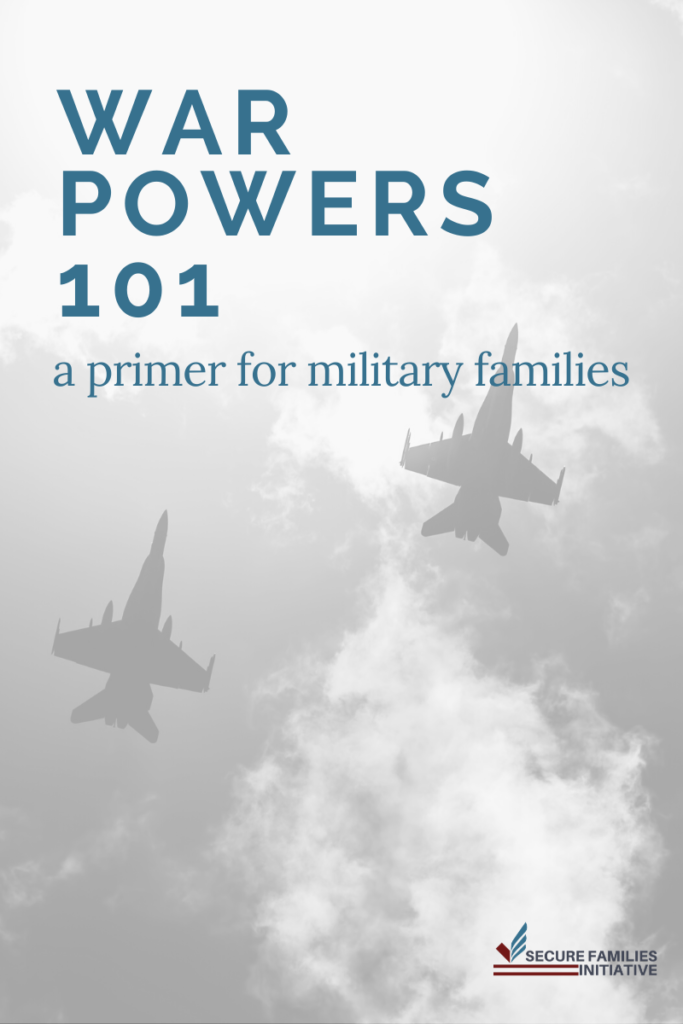There’s a buzz around Capitol Hill right now about whether our country should change the way it decides to go to war. Given the relevance of this issue to our military community, we thought it’d useful to lay out an overview of U.S. War Powers so we can better engage in these conversations.
1) What are “War Powers” and who has them in the United States?
“War Powers” refers to the constitutional authority to engage the United States in war or any other national crisis.
According to Article I, Section 8 of the U.S. Constitution (often referred to as the “War Powers Clause”), Congress has the sole authority to declare war.
Later in Article II, Section 2, the Constitution states that the President is the “Commander in Chief” of the U.S. military.
Put together, this means that Congress is responsible for initiating war, and the President is responsible for directing those activities once authorized to do so.

2) Sounds simple enough. Have there been any updates since then?
Yes, there have.
Over time, the inherent tension between these dual wartime responsibilities laid out in the constitution caused differing constitutional interpretations and resulted in conflicts between the Executive and Legislative branches.
Finally, in the aftermath of the Vietnam War (an undeclared conflict in which consecutive presidents deployed U.S. military forces without congressional authorization), Congress passed the 1973 War Powers Resolution in an attempt to clarify the combined war powers and lay out procedures for future conflicts. The desire for more congressional input into matters of war and peace was so significant that Congress overrode a presidential veto. Among the stipulations were:
- A reporting requirement: the President is expected to consult with Congress throughout the process and must notify Congress within 48 hours of deploying U.S. troops into hostilities, including the constitutional and legislative authority under which the deployment was made.
- A sunset requirement: the President must end foreign military actions after 60 days, unless Congress acts to extend through a declaration of war or other authorization.
It should be noted that every presidential administration since 1973 has held that the War Powers Resolution is unconstitutional, and several U.S. Presidents have taken actions that directly challenged these limits. In some cases, even when Presidents have reported to Congress in a way that was “consistent” with the War Powers Resolution, they refrained from citing the Resolution as the reason for reporting.
But overall, this has been understood to be the law of the land regarding war powers.
3) I’ve heard the term AUMF tossed around – what is that and how does it connect?
AUMF stands for “Authorized Use of Military Force.” As discussed above, the President is only supposed to engage in military action when Congress says so. This can happen through a formal declaration of war (particularly when the opposition is a nation state) or other authorization.
The two Congressional Authorizations that are most relevant to today’s conflicts are the 2001 and 2002 AUMFs:
- 2001: Three days after the 9/11 attacks, Congress voted nearly unanimously to give the President far-reaching powers to retaliate against the perpetrators of those attacks. Because Congress didn’t yet now who the perpetrators were, the language was left intentionally vague. No geographic boundaries or sunset provisions were included.
- 2002: Congress later passed a subsequent AUMF against Iraq. Through this resolution, the President was directed to “defend the national security of the United States against the continuing threat posed by Iraq” and help enforce UN Security Council resolutions.
In the 20 years since these AUMFs were passed, U.S. Presidents from both parties have used them as a pretext to engage in a wide range of military operations without seeking congressional approval, even when the connection to 9/11 or Iraq is ambiguous or nonexistent. The existing war authorities have been used to justify force in at least 41 operations in 19 countries across the Middle East and Africa.
You might hear someone say that the 2001 AUMF justifies military action against al Qaeda, the Taliban, and “associated forces.” However, the term “associated forces” appears nowhere in the law. This term was invented by White House lawyers to justify an ever-expanding array of conflicts – yet another example of how current congressional authorities are being distorted.
Many believe that these AUMFs should be reformed or repealed in order to realign U.S. War Power with the standards laid out in the Constitution, and to give the American people more of a say.
4) What’s the upshot of all this for Military Families?
Military families are directly impacted by our country’s decisions over war and peace. For us, “Use of Military Force” is not an abstract concept; it’s a somber reality.
The decision over whether to Authorize Military Force should be maximally deliberative and transparent. If our loved ones are going to be called upon to demonstrate the furthest bounds of their service, we deserve to be confident in the necessity and justness of that decision.
That is why the Secure Families Initiative joins the voices of our many partner organizations in calling for War Powers to be brought back to Congress.
5) Where can I learn more?
Radio Lab podcast did a fabulous episode on the 2001 AUMF called “60 Words.”
Seven members of Congress penned a relevant OpEd, “We differ in our politics. We agree on Congress’s power to declare war.“
Prefer pictures to reading? The Reiss Center on Law and Security made interactive graphics to track each President’s 48-hour reports under the War Powers Resolution.
For a more dense read, the Congressional Research Service published this overview in March 2019.


